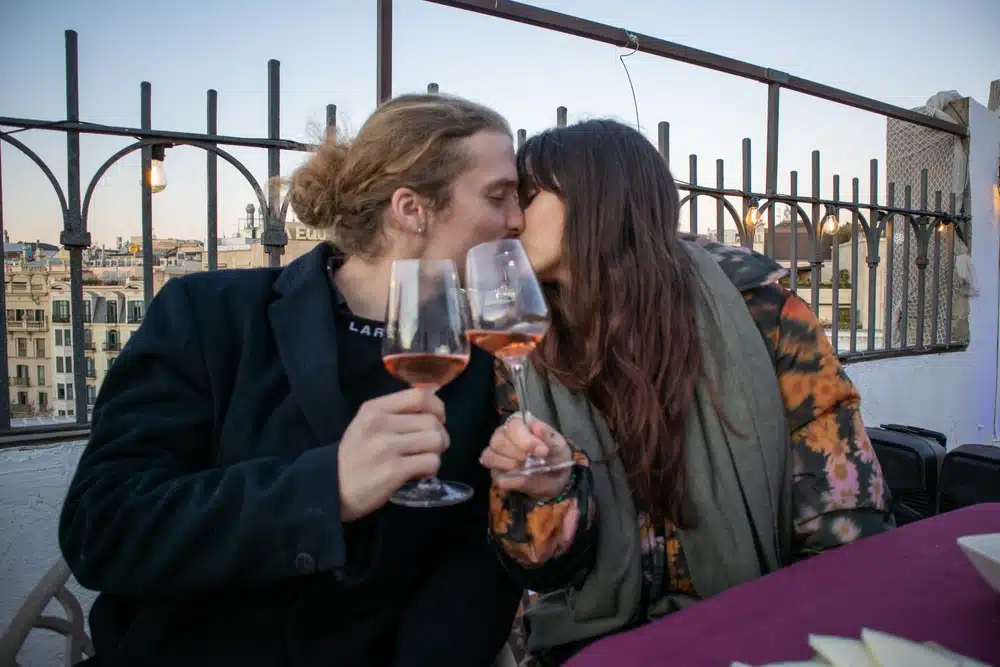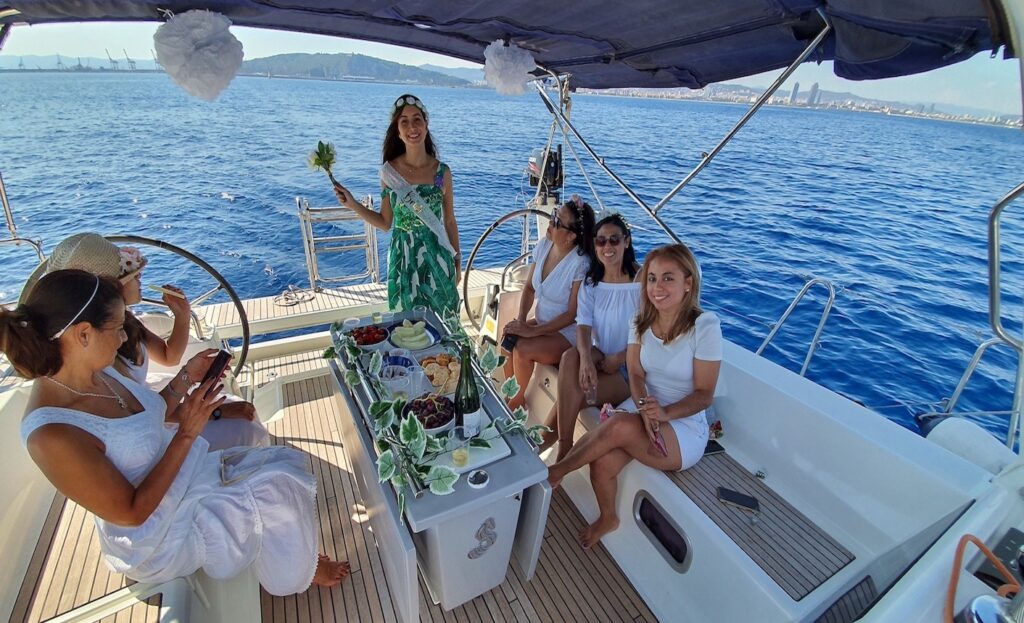There’s no wine that screams “I’m here for a good time” louder than rosé*. Nobody in the history of wine drinking has ever ordered a glass of rosé in a bad mood—nor finished one in one. It’s the drink of joy, of levity, of vibes. It carries a certain unseriousness that red wine often can’t muster (with all its talk of pairings and pedigree), and while white wine might have a claim to lightheartedness, its rise as the vin de rigueur among the unhoused means it’s seen more than its fair share of tragedy.
But rosé? Non. Rosé straddles the line—visually, structurally, and spiritually—between red and white. A brief fling with red wine skins gives it a whisper of tannin, a flicker of body, the tease of complexity. But because that fling was just a quickie, it still clings to the freshness and acidity of its more reserved, white wine cousin.
What we’re here to tackle today are the enduring myths—mainly that rosé’s colour has anything to do with its sweetness, dryness, or quality. Pale rosés, les rosés gris, have become fashion accessories for the Saint-Tropez set. In Provence, factories hum behind the Côte d’Azur pumping out crates of pastel-pink bottles, each one positioned as somehow drier, classier, better.
But you know what? That’s bullshit. Maybe even dangerous levels of smoke and mirrors. So let’s liberate you from the tyranny of needing pale rosé. Shall we?
*Yes, we’re talking about Spanish rosados, but we’ll stick with the très chic rosé for this article.

Rosé Colour Explained (Without the Pretension)
Let’s start with the basics: rosé gets its colour from grape skin contact. All wine juice—unless it’s from a red-fleshed grape, which is rare—is clear. The difference between a white, a rosé, and a red comes down to how long the grape skins stay in the juice after it’s pressed.
With rosé, it’s usually just a few hours. A quick flirtation. Enough to add a blush of colour, a hint of tannin, a bit of structure—and then the skins are yeeted out before things get too serious.
Now, here’s the key bit: longer skin contact = darker rosé, yes. But darker doesn’t mean sweeter, and lighter doesn’t mean drier. Colour is about extraction, not sugar. You can have a pale rosé that’s floral and fruity with residual sugar, and a deep salmon one that’s bone dry and packed with minerality.
But thanks to branding—looking at you, Provence—pale rosés have been marketed as the chic choice. Light colour has become shorthand for quality, dryness, and sophistication. Which is nonsense. If a rosé’s colour is the only thing selling it, it probably needs more personality.
Spanish rosés (rosados), especially those made from grapes like Garnacha, Tempranillo, or Bobal, often come in richer hues—rose golds, sunset oranges, dusty rubies. And you know what? They’re bloody delicious. They just don’t fit the pastel pink narrative that got dressed up and sold to us as “premium.”
A (Very) Brief History of Rosé
Rosé might feel like the new kid on the wine block, but it’s actually one of the oldest styles of wine in the world. In fact, the ancient Greeks and Romans were sipping something suspiciously rosé-looking long before wine bros were swirling Pinot Noir in Burgundy. Back then, all wine was basically rosé—because grapes were trodden and fermented with little control over colour extraction. Red wines were lighter, and nobody was trying to flex their cellar’s oak game.
Fast forward a couple thousand years, and rosé becomes a deliberate thing. France, Spain, and Italy all have long-standing rosé traditions, each shaped by local grapes, food cultures, and climate. In Spain, rosado has always been part of the drinking culture—especially in hotter regions where light reds or heavier whites just don’t cut it. Meanwhile, in Provence, the style got leaner, paler, and crisper, evolving into the delicate blush-pink look we now see flooding beach clubs and influencer feeds.
And that’s where our current pink obsession really began…
How Pale Rosé Took Over the World (and Why It Needs a Chill Pill)
So how did we get here—where lighter = better, and the sight of a rich, ruby-hued rosé makes people recoil like it’s a syrupy sin?
Blame Provence. And branding. In the early 2000s, Provence rosé producers, led by estates like Château d’Esclans (yes, the Whispering Angel people), decided they weren’t going to compete with reds or whites. They were going to turn rosé into a lifestyle. Crisp, pale, and photogenic, Provence rosé was marketed not just as a wine, but as an accessory. Something that looked just as good in a glass as it did on a yacht in St. Tropez, or poolside in Ibiza, or clutched by someone in white linen doing absolutely nothing of importance.
It worked. Provence leaned into their pale, dry style—and the rest of the world followed. Instagram helped. So did the word “angel” on the label. Suddenly, darker rosés were seen as passé, or worse—sweet. And pale pink became the international symbol of chic wine drinking, even if the contents of the bottle were often mid at best.
Now, we’re not here to slag off all Provence rosé (some of it’s lovely, truly). But the obsession with colour has led us all to overlook brilliant, bold, flavourful rosés—especially the ones coming out of Spain.
It’s time to pink differently.
Dark Rosé Isn’t Sweet – Get Over It
Let’s say it loud for the people at the back: just because a rosé is dark doesn’t mean it’s sweet. This is one of those persistent wine myths that’s managed to cling on like a bad hangover. And it’s time we let it go.
A darker rosé doesn’t mean more sugar—it just means more skin contact. The winemaker let the grape skins sit in the juice a little longer before straining them out. That adds colour. Sometimes a bit of body. Maybe a bit more grip. But sweetness? That’s got nothing to do with it.
Sweetness in wine comes from residual sugar—that is, how much sugar is left unfermented. And you can have pale rosés that are off-dry or even straight-up sweet (especially if they’re mass-produced), just like you can have dark rosés that are dry as your mate’s Tinder bio.
The problem is perception. Provence pale has been branded as elegant, while anything darker has been lumped in with the leftover syrup you find in sangria pitchers at the end of the night. But Spanish rosado is here to flip that narrative. These wines are often drier than you’d expect, bursting with red fruit, fresh acidity, and that delicious bit of tension that keeps you going back for more.
So let’s stop judging rosé like it’s a mood ring. Dark can be dry. Pale can be sweet. And neither tells the full story until you actually taste the damn thing.
The Spanish Take on Rosé: What Makes It Different
If you’ve only ever known rosé through the soft-focus lens of Provence, Spanish rosé might come as a bit of a shock. It’s bolder. It’s deeper. It’s less about looking pretty on a yacht and more about actually tasting something.
Here, rosé—or rosado, if we’re being local—isn’t an afterthought or a marketing move. It’s intentional. It’s crafted. It’s got structure, acidity, and body, and often packs more punch than its French cousins. That’s because the grapes going into these bottles—Garnacha, Tempranillo, Bobal, even Trepat—have something to say. And winemakers aren’t afraid to let them speak up.
While Provence has trained us to think “pale = refined,” in Spain, deeper colour doesn’t mean the wine’s going to smother you with sweetness. It just means the skins got a little more time in the mix—adding flavour, a little tannin, and a whole lot of character. Spanish rosados are vibrant, food-friendly, and made to be drunk with friends over grilled things, sunny terraces, and second bottles.
So if you’ve written off darker rosé as too sweet, or assumed Spanish means simple—this is your sign to unlearn that nonsense. Spanish rosé is here to shake up your palate. And it’s not asking for your permission.
How to Choose a Rosé You’ll Actually Like
Picking a rosé shouldn’t feel like defusing a bomb. But with all the colour confusion, label lies, and marketing fluff out there, it’s no wonder people just grab the palest bottle and hope for the best.
Here’s the real trick: go beyond the colour and start reading the clues that actually matter.
🏷 Look at the Grape(s)
If it’s Garnacha, expect ripe strawberry vibes, a bit of body, and usually a dry finish. Tempranillo can add structure and spice. Bobal brings juicy red fruit. Trepat? Floral and delicate. Knowing your grapes—even just a few—can tell you more than the shade of pink ever could.
📍 Check the Region
Navarra and Rioja are rosado strongholds, and they know what they’re doing. Wines from these regions tend to be balanced, food-friendly, and drier than most people expect. Catalan rosés often feature blends with local grapes like Sumoll or Trepat—light, fresh, and perfect for Mediterranean afternoons.
🧾 Look for Terms Like ‘Seco’ (Dry)
Or if it says afrutado (fruity) or semi-dulce, prepare for a sweeter ride. If it’s not on the label, ask the shop staff. Or better yet, ask us.
🧠 Ask Yourself What You Actually Like
Forget what you think you’re supposed to like. Do you want juicy and fresh? Rich and round? Bone dry with a bit of grip? The key is figuring out what makes your taste buds tingle—and choosing accordingly.
TL;DR: the palest rosé on the shelf isn’t necessarily the driest, and the darkest isn’t automatically sweet. Wine labels are weird, and marketing is a liar. Choose with your brain, not your eyes.
Best Rosés to Try While You’re in Barcelona
If you’re in Barcelona and ready to break free from the pale-pink propaganda, here are two standout rosés we feature in our tastings. They’re unapologetically Spanish, full of character, and guaranteed to make you rethink everything you thought you knew about rosé.
1. Izadi Larrosa Garnacha Rosé (Rioja)
This rosado is a masterclass in how Garnacha can shine in rosé form. Crafted from 60-year-old vines perched at 790 meters in Rioja Alavesa, it pours a shimmering salmon pink. But don’t let the delicate hue fool you—this wine packs a flavorful punch.
Expect aromas of pink florals, red berries, and ripe stone fruit, with a palate that balances watermelon and pomegranate notes against a backdrop of vibrant acidity. It’s grippy, fresh, and fuller than your typical Provence pink, making it a more intriguing choice for those seeking depth in their rosé.
2. Anaïs Rosat 2024 (Catalonia)
A local gem that’s as bold as it is beautiful. Anaïs Rosat 2024 showcases the richness of Catalan rosé, offering a deeper hue that hints at its complexity. While specific reviews for this vintage are scarce, its inclusion in our tastings is a testament to its quality and appeal.
This rosé defies the pale equals premium myth, delivering a wine that’s both vibrant and versatile. It’s a perfect companion for Barcelona’s sunny terraces and seafood feasts, embodying the spirit of the region in every sip.
Want to Learn More? Come Taste With Us
We could keep talking about rosé forever (clearly), but at some point you’ve got to stop reading and start sipping.
If this article has made you question everything you thought you knew about pink wine—good. That means it’s working. But don’t just take our word for it. Come taste these wines with us. Hear the stories. Swirl, sniff, sip, suck, swallow, and savour like the gorgeous wine-drinking human you are.
Our tastings are relaxed, informative, and completely free of wine wankery. You’ll try wines like the Anaïs Rosat and Izadi Garnacha Rosado, learn why they taste the way they do, and leave feeling a little smarter and a lot more confident next time you’re faced with a shelf full of blush bottles.
We’re not here to teach you how to drink wine the right way. We’re here to help you discover your way.
So come thirsty. We’ll take care of the rest.



